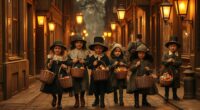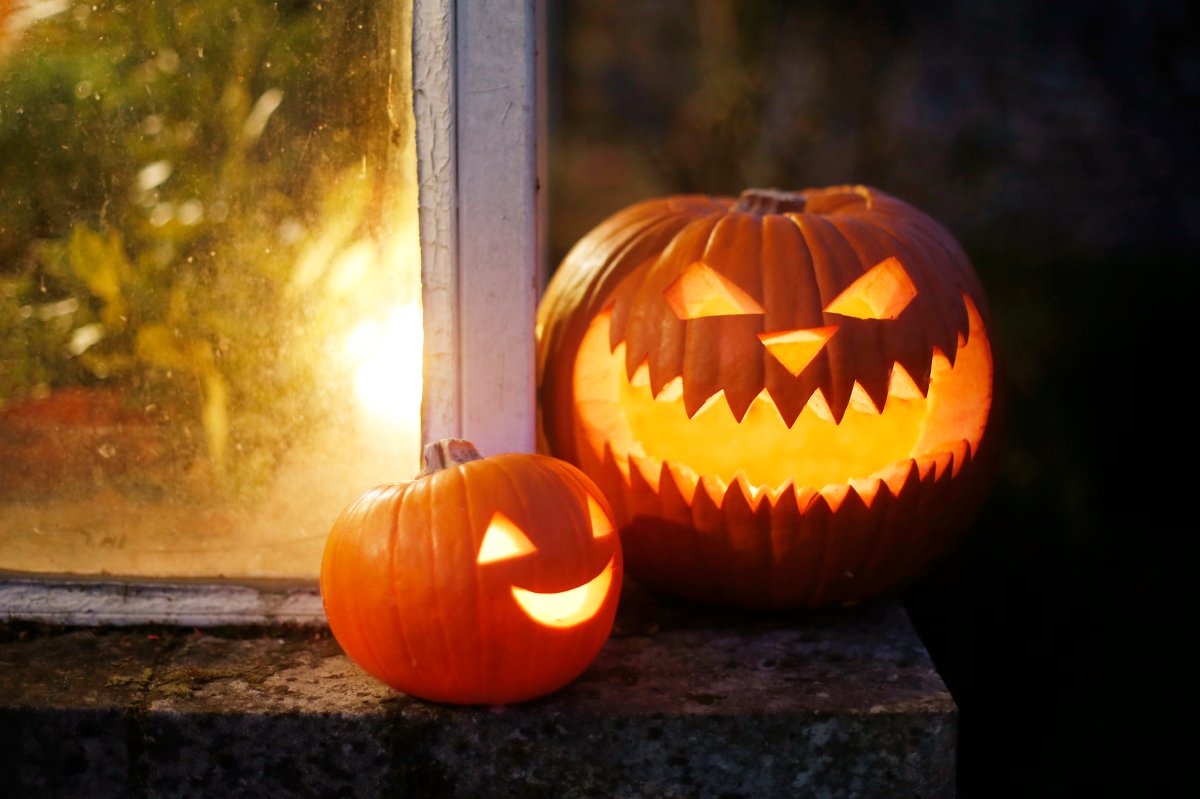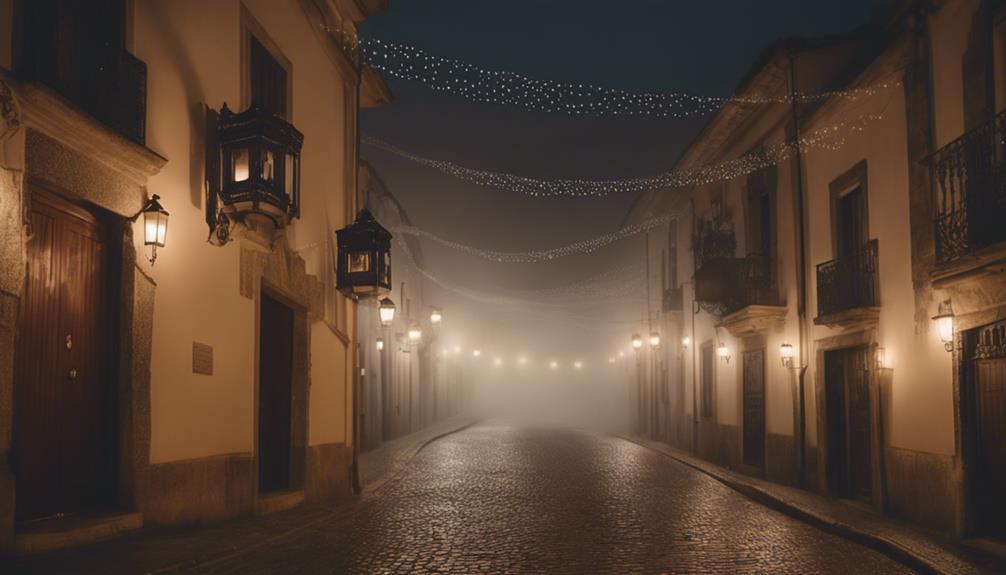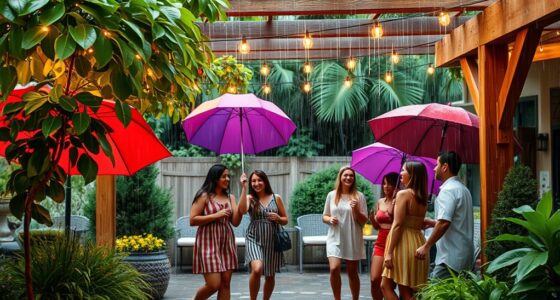Halloween started over 2,000 years ago with the Celtic festival of Samhain, when people believed spirits wandered and held rituals to honor ancestors and ward off ghosts. As years passed, these traditions merged with Christian customs, becoming All Hallows’ Eve and eventually Halloween. Over time, it shifted from solemn observances to festive community events like trick-or-treating and costumes. To discover how these ancient roots shape today’s celebrations, keep exploring the fascinating history behind Halloween.
Key Takeaways
- Halloween originated from Celtic Samhain rituals honoring spirits and marking the boundary between the living and the dead.
- It evolved into All Hallows’ Eve through Christian blending, shifting from solemn rites to communal celebrations.
- Disguises and masks historically served to protect against spirits and mimic supernatural beings during ancient and medieval times.
- Trick-or-treating and festive decorations developed from old customs like “souling” and “guising” in the 19th and 20th centuries.
- Today, Halloween combines ancient traditions with modern festivities, including costumes, pumpkin carving, and spooky decorations.

Have you ever wondered how Halloween became the spooky holiday we celebrate today? It all traces back to ancient rituals performed by Celtic tribes during the festival of Samhain. Thousands of years ago, people believed that on October 31st, the boundary between the living and the dead was especially thin. They held bonfires and performed rituals to honor their ancestors, believing that spirits would cross into the world of the living. These ancient rituals aimed to ward off wandering spirits and ensure a safe winter. Over time, these practices evolved, blending with other cultural influences, but the core idea of honoring spirits persisted.
Halloween roots trace back to Celtic Samhain rituals honoring spirits and warding off wandering ghosts.
As centuries passed, the traditions of Samhain gradually merged with Christian customs, especially as the church sought to replace pagan festivals. The holiday was renamed All Hallows’ Eve, which eventually shortened to Halloween. During this period, some traditions shifted from solemn rituals to more communal celebrations, including costumes and games. People began dressing up in masks and disguises—early versions of modern costumes—to hide themselves from spirits or to mimic them. These disguises served both as protection and as entertainment, a tradition that persists today in the form of creative and spooky costumes. You might think of Halloween costumes as just fun dress-up, but historically, they have roots in ancient fears and superstitions meant to confuse spirits or appease them.
Moving into the 19th and 20th centuries, Halloween started to take on a more playful tone. Communities began hosting parties, trick-or-treating, and decorating their homes with carved pumpkins and spooky motifs. The idea of children going door-to-door for treats grew out of older customs like “souling” and “guising,” where kids would perform small acts to earn food or gifts. These traditions transformed into the modern practice of trick-or-treating, creating a festive, community-centered atmosphere. You might enjoy how today’s costumes range from creepy monsters to beloved characters—yet, they still echo the ancient practice of disguise, rooted in centuries-old rituals.
Ultimately, Halloween’s history is a fascinating blend of ancient beliefs, religious shifts, and cultural adaptations. From the ancient rituals of honoring spirits during Samhain to the creative, modern costumes, the holiday has continually evolved. What started as a solemn and mysterious observance has become a fun-filled celebration that embraces spooky, silly, and supernatural themes. So, next time you put on your costume or carve a pumpkin, remember you’re participating in a tradition that’s thousands of years old, rooted in the desire to connect with the spirits of the past and enjoy the thrill of the present.
Frequently Asked Questions
How Did Halloween Costumes Originate?
You might wonder how Halloween costumes originated. Back in the day, people wore masks and costumes during masquerade balls to hide their identities and ward off spirits. Over time, these costume traditions evolved into dressing up for Halloween, allowing people to become characters or creatures. Today, you still enjoy dressing up in various costumes, continuing the fun and mysterious spirit of those early masquerade traditions that started centuries ago.
What Are the Cultural Differences in Halloween Celebrations Worldwide?
Imagine exploring how different cultures put their unique spin on Halloween’s festivities. You’ll find cultural variations that reflect local beliefs, traditions, and customs, making each celebration special. From elaborate costumes in the U.S. to spooky festivals in Mexico and traditional rituals in Ireland, international customs shine through. These differences highlight Halloween’s adaptable nature, allowing you to experience a rich tapestry of spooky fun around the world, each adding its own flavor to the holiday.
When Did Trick-Or-Treating Become Popular in America?
You might find it interesting that trick-or-treating history dates back to the early 20th century, gaining popularity in America during the 1920s and 1930s. It became a key part of American Halloween traditions, especially after WWII, when communities embraced it as a fun, safe activity for children. Today, trick-or-treating is one of the most iconic American Halloween traditions, enjoyed nationwide every October 31st.
Are There Any Halloween Superstitions Still Believed Today?
You might notice that some Halloween superstitions still persist today, even if many consider them modern beliefs. For example, people often avoid walking under ladders or believe black cats bring bad luck. These superstitions remain part of the holiday’s fun traditions, blending old fears with new celebrations. Their persistence shows how cultural beliefs can adapt over time, keeping the spooky spirit alive while still being playful and entertaining.
How Has Halloween Influenced Modern Pop Culture?
You might notice Halloween’s influence in pop culture through costume evolution, where creative ideas turn into iconic looks, and horror films that thrill audiences worldwide. These elements shape your celebrations and entertainment choices, blending tradition with modern flair. You can enjoy how horror movies popularize spooky themes, while costume evolution keeps your dress-up game fresh. Halloween’s impact on pop culture is clear—it’s a blend of fright and fun that keeps evolving with you.
Conclusion
So, even if you think Halloween is just about costumes and candy, remember it’s rooted in centuries of tradition and history. Understanding its origins can make your celebrations more meaningful. Don’t dismiss Halloween as just a spooky holiday—embrace its rich past and the way it brings people together. After all, knowing where it’s from can make your experience even more fun and memorable. So, go ahead and enjoy Halloween with a new appreciation!









